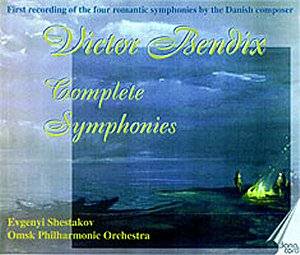VICTOR BENDIX
(1851-1926)
Symphony No 1 Mountain Climbing (1882)
Symphony No 2 Sounds of Summer from South Russia (1888)
Symphony No 3 (1895)
Symphony No 4 (1906)
 Omsk PO/Evgeni Shestakov
Omsk PO/Evgeni Shestakov
rec Omsk 1995 (syms 1-3) July-Aug 1999 (sym
4)
 DANACORD DACOCD436-7 CD1 [66.37]; CD2
[66.04]
DANACORD DACOCD436-7 CD1 [66.37]; CD2
[66.04]
Crotchet

Bendix was born into a musically-inclined family in Copenhagen. He was taught
by Niels Gade and was an early student at the Copenhagen Conservatoire. He
travelled to Germany on a scholarship. He attended the foundation stone ceremony
for Wagner's Bayreuth Theatre. He took his 1884 piano concerto on tour through
Europe. His wife Dagmar played the concerto in London. He preserved a sparkling
and assertive piano technique well beyond the age of seventy.
The Royal Danish Orchestra avoided his music. Despite this he was regarded
as a person of high eminence in Danish musical life. His works include various
overtures and suites, Psalm 33 for chorus and orchestra (1874), a Piano Trio
(1888), and a circa 50 minute piano sonata.
A romantic composer to the core he may be compared with Raff and Glazunov.
On this evidence he is less a dramatist than a weaver of idylls and a steadily
surging romance.
In his first symphony there is a contentment that is simultaneously of Brahms
and Schumann. The symphony is inspired by Holger Drachmann's poem 'Mountain
Climbing'. The notes make something of possible links with Liszt's Ce
qu'on entends sur la montagne. Themes are fresh if not quite as durable
and 'springy' as the Bizet and Goldmark symphonies, works which, together
with the Hartmann and Ludolf Nielsen symphonies, the Bendix symphonies may
be grouped. In the finale (where there were some defects of ensemble in the
opening bars) I was reminded of Arthur Sullivan's Irish Symphony.
The Third Symphony's first movement is intensely emotional and uses the woodwind
most poignantly. There are several passages for solo instruments. The style
is old-fashioned beside Nielsen .... however what of it. Bendix is tender
and can dream day-dreams with the best of them. I thought of Stanford's
symphonies as a parallel but his way with music is more probingly impassioned
than the Irish composer taking a little of Tchaikovsky. The movement ends
in great tenderness. The scherzo has some of that hiccuping snarl typified
by Nielsen in the Choleric movement from his Second Symphony alongside
a hint of Bizet from L'Arlésienne. Shestakov builds ineluctably,
steadily and remorselessly and grasps some grandly lyrical moments as in
7.19 (finale) where the strings, in plush depth and swell, sing in wondering
confidence. This, for me, is the outstanding highlight of the disc. Courageously
(and effectively) Bendix ends the work with a slow warm sunset rather than
a blazing Valhalla.
The Second Symphony is pastoral in mood. Its Russian theme is confirmed by
the snap and colouring of some of melodies and motifs but this is more of
a Danish idyll (lively enough, mind you) than a Russian nationalist work.
There is something of Alfven's Midsommervarka about the woodwind and
the movement ends with a charming paraph in sound from the woodwind who also
dance in Glazunov-like charm in the flighty scherzo. The andante deploys
a theme recalling nostalgic early Sibelius. Once again I was reminded of
the pastoral mood suites of Ludolf Nielsen. The finale barrels along like
a cousin of the Bartered Bride overture but ends in relaxation.
The Fourth Symphony is unpublished. It is dedicated to Dagmar, the composer's
second wife, and in the first movement is suggestive of Brahms' Haydn
Variations at one moment, Nielsen in Second Symphony mode at the next
and the Schumann of the Spring and Rhenish symphonies. The
roughened Hurdy-Gurdy charm of the Intermezzo and its Elgarian wistfulness
evolve in the third movement into the rounded succulent pastoralism of Nielsen's
Espansiva. This sports some very fine playing from the brass and woodwind.
The finale, where I have to say that inspiration sputters, does not have
the polish and unanimity of the rest of the set although there is no lack
of spark in some characterful solo work as at 3.10.
The notes, by Danacord regular Mogens Wenzel Andreasen, are in Danish and
English.
Jesper Buhl is the guiding light of Danacord and as great a name as Sterling's
Bo Hyttner and as Lyrita Recorded Edition's reclusive Richard Itter. Buhl
provides the background notes on the orchestra and how the recording came
about. Buhl chose bravely and well with the Omsk Orchestra and with Shestakov.
The strings are notably rich. The recording is to match, made with SONY digital
equipment from the local Irtish state radio station. Thanks are certainly
due to the West Siberian authorities, the radio station and the engineer
Euginie Shabanov for a de luxe production of music otherwise choked into
silence by the dust of neglect.
This is another treasurable achievement from Danacord. Would that their Louis
Glass cycle could have been issued in a single box rather than the slow
incremental approach which so far has borne to us only Symphony No. 4.
The Third Symphony is an outstanding piece. Not up to Louis Glass's Fifth
Symphony (but then few works are) but glowing and sturdily romantic. I urge
you to acquire this engagingly pleasurable set if you have any feeling for
Glazunov, Kopylov, Glass, Atterburg, Ludolf Nielsen, Karlowicz or Borodin.
Rob Barnett

See also review by Gerald Fenech

